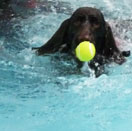Benefits

• Relief of pain, swelling and stiffness
• Stress free support to muscles and joints with zero impact
• Increases range of muscle movement and joint mobilization
• Builds and maintains muscle mass
• Improves cardio vascular fitness
• Improves a dogs mental state
Common Conditions Which Benefit From Hydrotherapy
Hip Dysplasia - This type of disease directly affects the hip joints of dogs, which is the bone structure that attaches the dog’s body to the hind legs. The hips joints are ball and socket joints that rotate freely to allow dogs to walk normally. There are two ball and socket joints present both in animals and humans, one for each leg. If these two joints don’t match in shape and in form, or if one of them is grows abnormally, limping will occur. This is one the symptoms of hip dysplasia.
Hip dysplasia normally occurs during a young dog’s growing stages. Hip dysplasia may affect both the left and right hips, causing intense discomfort to your pet. The disease usually develops due to the laxity of the ligaments, connective tissues, and muscles around the joints.
Elbow Dysplasia - Similar to hip dysplasia, elbow dysplasia (ED) is caused by the abnormal development of the elbow joint due to problems in the growth of the cartilage on the surface of the joint or the structures around it. These growth problems lead to secondary osteoarthritis, which is irreversible and will cause lameness and pain. The disease can begin in puppyhood and affect the dog for the rest if its life. Unfortunately, the elbow seems to be especially prone to this type of disease due to its construction similarity to a hinge and its propensity for high motion. It is also the joint which normal forelimb gait is most dependent on and so any small changes in any part of the joint will cause large changes in function.
Arthritis - arthritis is an inflammation of the joints. The joints, or hinges of the skeletal system, are responsible for coordinating the movement of a dog. All activities, such as running and jumping, require the use of the dog's leg joints. Over time, or because of injury or infection, the tissue in the joints becomes inflamed and causes serious pain for the dog. There are three types of arthritis osteo, rheumatoid and infectious and can be very painful for the dog.
Cranial Cruciate Ligaments - A cruciate ligament injury is the result of a partial or complete rupture (tear). The cranial (anterior) cruciate ligament is the one more commonly affected, though the caudal (posterior) can rupture as well. When the cruciate ligament tears, the tibia moves freely from under the femur, resulting in pain and abnormal gait. Sudden lameness in a rear leg is often the first sign of injury. If an injury remains unaddressed, arthritic changes can begin quite quickly, causing long-term lameness and discomfort.
Obesity - Dogs are considered to be obese when they weigh more than 15% over their ideal body weight according to their breed type. The health risks to an overweight dog are serious and can be life-threatening. Conditions which can occur through obesity include arthritis, bone and ligament damage, high blood pressure, diabetes, repertory problems and cancer.
Strokes - Canine stroke, although rare as a dog health problem, occurs when the blood flow is disrupted to the brain due to either a blocked artery or a hemorrhage. Common signs include head tilt or turn, loss of balance, loss of vision, circling and falling.
Legg Calve Perthes Disease – caused by the blood supply stopping to the hip joint, causing the joint to shrink, usually found in small breeds.
Osteochondrosis Dessicans (OCD) – this occurs when a layer of cartilage covers the end of the bone and continues to grow quicker than the growth of the dog. Causes pain when walking. It is most commonly seen in the stifle, elbow, shoulder, and hock.
Patella Luxation - The patella is the bone we know as the knee cap. A groove in the end of the femur allows the patella to glide up and down when the knee joint is bent back and forth. In some dogs, because of malformation or trauma, the ridges forming the patellar groove are not prominent, and a too-shallow groove is created. In a dog with shallow grooves, the patella will luxate (jump out of the groove) sideways, especially toward the inside. This causes the leg to 'lock up' with the foot held off the ground. Usually found in small breeds.





